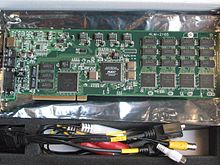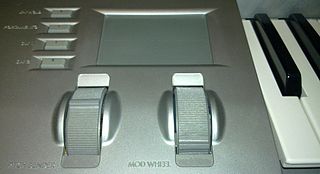Korg OASYS PCI
Last updated| OASYS PCI | |
|---|---|
 Korg OASYS PCI | |
| Manufacturer | Korg |
| Dates | 1999-2001 |
| Price | $2,000 |
| Technical specifications | |
| Polyphony | 16 (maximum; may vary depending on DSP load) |
| Timbrality | 12 |
| Oscillator | depends on synthesis engine |
| Synthesis type | PCM, Physical Modelling, Sampler, Analog Modelling |
| Filter | depends on synthesis engine |
| Input/output | |
| Keyboard | no |
| External control | MIDI |
The Korg OASYS PCI is a DSP-based PCI-card for PC and Mac released in 1999. It offers many synthesizer engines from sampling and substractive to FM and physical modelling. Because of its high market price and low polyphony, production was stopped in 2001. About 2000 cards were produced.
Contents
Engines
Some of the models were taken from Korg Z1 hardware synthesizer.
ROMpler
Virtual Analog
- Analog 1 Osc - basic analog synthesizer with one oscillator;
- Analog 2 Osc - same as previous, but with two oscillator. Consume less DSP-power than two copy of Analog 1 Osc;
- Analog Bass-Lead - simple synthesizer dedicated for solo and bass sounds;
- Comb Synth - same as previous, but with comb filter;
- KB-303 - model of Roland TB-303 bass synthesizer;
- Mini Synth - model of Minimoog synthesizer;
- Noise Synth - noise synth for percussion sounds and effects;
- Pro Synth - model of Sequential Circuits Prophet-5 synthesizer;
- Pro Synth Mod - same as previous with two more envelope generators and control elements.
Physical modelling
- Reed Piano - model of popular e-piano;
- Plucked String - acoustic guitar and other plucked string instrument model;
- Small Plucked String - lite version of previous mode. Consume less DSP power;
- Slap Bass - bass guitar model;
- Small Slap Bass - lite version of previous mode. Consume less DSP power;
- Tonewheel Organ - electric organ model.
- Z1 Organ - model taken from Korg Z1. Sounds pretty the same;
- Tenor Sax - physical model of Saxophone.
Drum Synthesizer
- Percussion Synth - drum machine similar to Korg Electribe R.
- Percussion Synth 2 - same as previous with one more envelope generators;
- Beat Box - 3-track drum machine with 16-step sequencer and two Percussion Synth 2.
Virtual Phase Modulation (Frequency modulation)
Effects
Card comes with basic effects package based on 17 categories. Many of them taken from Korg Trinity workstation synthesizer.
Extensions
Korg released Synth Kit software for Mac OS 9 for extensions developing. Some of addition plugins were released to expand card capabilities:
- Harm Visser (acoustic modelling instruments)
- Dan Philips (effects and tools)
- Orwell Digital (VA and percussion synthesizer)
- Zarg Music (Orion synthesizer)
Compatibility
Because of fast market fail, no drivers were released for (then) modern operation systems including Windows XP and Mac OS X. Most of users had to have dedicated computer for Korg Oasys PCI on Windows ME/98.
Successor
The Korg OASYS workstation synthesizer released in early 2005.
See also
Bibliography
- Trask, Simon (April 2000). "Korg OASYS PCI - Synthesis, Effects & Audio Card". Sound On Sound . Archived from the original on 8 June 2015.
Korg's longstanding OASYS synthesis project has finally come to commercial fruition. The original plan, to produce a traditional stand-alone synthesizer, has given way to a computer-based synthesis and mixing environment running on a multi-DSP PCI card. Simon Trask takes refuge with the OASYS PCI...
(see also a column on this article: "Native Vs DSP: Dan Phillips (Korg R&D) On Processing Power")
Related Research Articles

A digital synthesizer is a synthesizer that uses digital signal processing (DSP) techniques to make musical sounds. This in contrast to older analog synthesizers, which produce music using analog electronics, and samplers, which play back digital recordings of acoustic, electric, or electronic instruments. Some digital synthesizers emulate analog synthesizers; others include sampling capability in addition to digital synthesis.

An analogsynthesizer is a synthesizer that uses analog circuits and analog signals to generate sound electronically.
Digital waveguide synthesis is the synthesis of audio using a digital waveguide. Digital waveguides are efficient computational models for physical media through which acoustic waves propagate. For this reason, digital waveguides constitute a major part of most modern physical modeling synthesizers.
The Yamaha AN1x is a DSP-based analog modeling synthesizer, produced by Yamaha Corporation from 1997 to 1998, and was marketed as an "analog physical modelling control synthesizer".

The Korg OASYS is a workstation synthesizer released in early 2005, 1 year after the successful Korg Triton Extreme. Unlike the Triton series, the OASYS uses a custom Linux operating system that was designed to be arbitrarily expandable via software updates, with its functionality limited only by the PC-like hardware.
An analog modeling synthesizer is a synthesizer that generates the sounds of traditional analog synthesizers using DSP components and software algorithms. Analog modeling synthesizers simulate the behavior of the original electronic circuitry in order to digitally replicate their tone.

The microKORG is a MIDI-capable digital synthesizer/vocoder from Korg featuring DSP-based analog modelling. The synthesizer is built in such a way that it is essentially a Korg MS-2000 with a programmable step arpeggiator, a less advanced vocoder, lack of motion sequencing, lack of an XLR microphone input, and in a smaller case with fewer real-time control knobs.

The Korg Prophecy is considered one of the earliest (mid-nineties) virtual analog synthesizers, although its synthesis capabilities went beyond many of its VA contemporaries.

The Korg Trinity is a synthesizer music workstation released by Korg in 1995. It was also the first workstation to offer modular expansion for not only sounds, but also studio-grade feature such as ADAT, various sound engine processors, audio recording capability, and more. It was considered one of the most comprehensive music workstations, in term of features, at the time.

The Access Virus is a virtual analog synthesizer made by the German company Access Music GmbH. It was first produced in 1997 and has since been upgraded frequently, with the company releasing new models about every two years. Early models include the Virus A, Virus B, and Virus C series, each available in various hardware configurations. In November 2005, the Virus TI series was released, including the 61-key Virus TI Keyboard and the 37-key Virus TI Polar. A small desktop model was released in February 2008 called the Virus TI Snow. A revision of the TI series called TI2 came out in March 2009, featuring faster digital signal processing (DSP) controllers, additional polyphony, more effects in the effect section and a slightly changed design. The Virus series also has come out with two software plugin versions: TDM for Pro Tools and VST for TC Electronic Powercore series. The term Access Virus can be used to refer to any one of these synthesizers.
Synapse Audio Software is a software company located in Germany. Previously known as Sonic Syndicate and headed by Richard Hoffmann, they develop music production software for the Mac OS and Microsoft Windows platforms. They started developing software in November 1998 as Sonic Syndicate and changed their name to Synapse Audio with the release of Orion Platinum in 2002.

The Korg Polysix(PS-6) is a six-voice programmable polyphonic analog synthesizer released by Korg in 1981.

The Korg MS2000 is a virtual analog synthesizer produced by the Japanese electronic musical instrument manufacturer Korg.

The Korg Wavestation is a vector synthesis synthesizer first produced in the early 1990s and later re-released as a software synthesizer in 2004. Its primary innovation was Wave Sequencing, a method of multi-timbral sound generation in which different PCM waveform data are played successively, resulting in continuously evolving sounds. The Wavestation's "Advanced Vector Synthesis" sound architecture resembled early vector synths such as the Sequential Circuits Prophet VS.

A synthesizer is an electronic musical instrument that generates audio signals. Synthesizers typically create sounds by generating waveforms through methods including subtractive synthesis, additive synthesis and frequency modulation synthesis. These sounds may be altered by components such as filters, which cut or boost frequencies; envelopes, which control articulation, or how notes begin and end; and low-frequency oscillators, which modulate parameters such as pitch, volume, or filter characteristics affecting timbre. Synthesizers are typically played with keyboards or controlled by sequencers, software or other instruments, and may be synchronized to other equipment via MIDI.
Casio's SDSynthesizers were a late-1980s line of analog synthesizers featuring a resonant filter. SD synthesis was traditional DCO-analog synthesis, with the main difference being that some of the SD waveforms' harmonic spectrums changed temporally, or dynamically in relation to the amplitude envelope. SD synthesis is used in six Casio synthesizers and home keyboards released in 1987 and produced until 1991, when Casio exited the synthesizer market completely and focused solely on pure consumer keyboards. Due to some programming limitations plus Casio's poor marketing, the SD synths never gained wide popularity and are now fairly rare in the second-hand marketplace. There still exists a small but devoted fanbase who insist that SD synthesis, particularly as expanded in the high-end model HT-6000, was overlooked and highly underrated and today really rare

The Korg RADIAS is a virtual analog synthesizer and Vocoder, released by Korg in 2006. The RADIAS' MMT engine was based on the Korg OASYS synthesizer module, providing for several different synthesis methods, two of which may be combined in a single voice e.g. phase distortion synthesis can be combined with subtractive synthesis. The different synthesis methods employed by MMT represent the majority of methods used historically in other Korg synthesizers: digital waveguide synthesis Korg first used in the Korg Z1 and phase distortion synthesis was first used in the Korg DS-8. This flexibility allows for very realistic emulations of past Korg synthesizers, though stays away from trying to emulate the Korg M1 and the Korg Wavestation,. As well as using the in-built waveforms for the basis of sound creation, the RADIAS allows for the input of an external signal which may be routed through the various sound shaping devices. The RADIAS has a comprehensive matrix modulation specification and to further enhance a sound the 'Wave Shaper' module allows for various sound distortion effects.

The Kronos is a music workstation manufactured by Korg that combines nine different synthesizer sound engines with a sequencer, digital recorder, effects, a color touchscreen display and a keyboard. Korg's latest flagship synthesizer series at the time of its announcement, the Kronos series was announced at the winter NAMM Show in Anaheim, California in January 2011.

The Korg Z1 is a physical modelling sound synthesiser released in 1997. Touted as a polyphonic Prophecy, the Z1 implements 13 synthesis types, all derived from the original OASYS synthesizer.
Text is available under the CC BY-SA 4.0 license; additional terms may apply.
Images, videos and audio are available under their respective licenses.